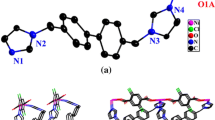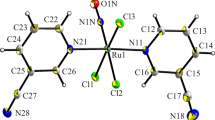Abstract
The double cyanides of nickel and platinum form structures capable of enclosing also phenol, for example, as guest molecule. Such clathrates are Ni(NH3)2Pt(CN)4 2 C6H5OH and Ni(en)2Pt(CN)4 · 0.14 C6H5OH. In the case of the tetracyano complexes, different thermal stabilities of their clathrate compounds could be achieved by alteration of the constituents of the cage structure and also of the guest molecules. According to the thermal behaviour, the clathrates may be divided into two groups: those which release the guest molecules in the first step of thermal decomposition (Ni(NH3)2Pt(CN)4· 2 C6H5OH), and those which lose the guest component only after partial destruction of the host cage (Ni(en)2Pt(CN)4 · 0.14 C6H5OH). The temperature ranges of loss of the guest component may determine the interval for their use in sorptive experiments. The temperature range for release of phenol from Ni(NH3)2Pt(CN)4 · · 2 C6H5OH is 55–244°, and from Ni(en)2Pt(CN)4 · 0.14 C6H5OH is 139–284°. The model host molecules NiPt(CN)4 · 6 H2O and Ni(en)3Pt(CN)4 · 3 H2O were also studied by thermal analysis.
Résumé
Les cyanures doubles de nickel et de platine forment une structure capable de se comporter comme une « structure d'accueil » vis-à-vis de la molécule de phénol. Les composés Ni(NH3)2Pt(CN)4·2 C6H5OH et Ni(en)2Pt(CN)4·0.14 C6H5OH entrent dans cette catégorie. Dans le cas des tétracyanocomplexes, on a pu atteindre une stabilité thermique différente de celle de leurs clathrates en changeant les constituants de la structure d'accueil ainsi que des molécules encagées. Leur comportement thermique se divise en deux groupes: dans le premier, les molécules encagées se dégagent lors de la première étape de la décomposition thermique [Ni(NH3)2Pt(CN)4·2 C6H5OH], tandis que le deuxième groupe ne perd le composant encagé qu'après destruction partielle de la molécule d'accueil [Ni(en)2Pt(CN)4·0.14 C6H5OH]. Les intervalles de température où s'effectue le départ du composant encagé permettent de prédire l'intervalle de leur utilisation dans les expériences de sorption. On a étudié, par analyse thermique, également les molécules d'accueil NiPt(CN)4·6 H2O et Ni(en)3Pt(CN)4·3 H2O.
Les intervalles de températures du dégagement du phénol sont 55–244° pour Ni(NH3)2Pt(CN)4·2 C6H5OH et 139–284° pour Ni(en)2Pt(CN)4.0.14 C6H5OH.
Zusammenfassung
Die Struktur der doppelten Cyanide von Nickel und Platin bietet die Möglichkeit auch Phenol als Gastmolekül einzuschließen. Hierzu zahlen Verbindungen wie Ni(NH3)2Pt(CN)4.2 C6H5OH und Ni(en)2Pt(CN)4·0.14 C6H5OH. Bei den Tetracyanokomplexen konnte eine verschiedene Wärmebeständigkeit ihrer Klathratverbindungen durch Änderung der Bestandteile der Käfigstruktur und auch der Gastmoleküle erreicht werden. Ihr thermisches Verhalten kann in zwei Gruppen unterteilt werden: die erste Gruppe verliert das Gastmolekül in der ersten Stufe der thermischen Zersetzung [Ni(NH3)2Pt(CN)4·2C6H5OH], die zweite nur nach teilweiser Zerstörung des Empfängerkäfigs [Ni(en)2Pt(CN)4·0.14C6H5OH]. Der Temperaturbereich der Abgabe der Gastkomponente gestattet Voraussagen bezüglich ihres Nutzungsbereichs in Sorptionsexperimenten. Die Modelle ihrer Gastmoleküle, NiPt(CN)4·6 H2O, Ni(en)3Pt(CN)4·3 H[2O wurden ebenfalls mittels Thermoanalyse untersucht.
Die Temperaturbereiche der Phenolabgabe sind 55 bis 244° bei Ni(NH3)2Pt(CN)4 · ·2 C6H5OH und 139 bis 284° bei Ni(en)2Pt(CN)4 ·0.14 C6H5OH.
Резюме
Изучено дегидроксил ирование С3АН6 и C3AD6 минералов с помощью и зотермического ТГ ме тода в атмосфере возд уха и в постоянном токе азота. Найдено, чт о механизм дегидроксилировани я в атмосфере воздуха изменяется в процессе реакции. При работе в динамической инертн ой атмосфере, экспери ментальные данные очень близко с оответствуют кинети ческой модели первог о порядка. Полученные значения энергии акт ивации для С3АН6 и C3AD6, соответстве нно равны 85.4 кдж·моль−1 и 103.4 кдж·моль−1.
Similar content being viewed by others
References
A. Sopková, Zbornik prednások Termanal' 73, (1973) A 77.
A. Sopková, V. Jesenák, J. Chomic,M. Dzurilová andE. Matejčiková, Thermal Analysis, Proc. 4th ICTA, (J. Buzás ed.), Akadémiai Kiadô, Budapest, 1 (1975) 863.
A.Sopková and M.Singliar, unpublished work.
A. Sopková, J. Chomic andE. Meteiciková, Monatsh. Chem., 102 (1971) 961.
J. Skoršepa, J. Chomic andE. Matejciková, Monatsh. Chem., 107 (1976) 297.
A. Sopková, Proc. First European Symposium on Thermal Analysis, (D. Dollimore ed.), Heyden, London, 1976, 153.
A. Sopková, J. Bubanec andK. Györyová, Zbornik prednások Termanal 76, (1976) A 21.
J. N. Kazankin andA. A. Paladiev, Z. obsc. Chim., 43 (1973) 2670.
A.Sopková, J.Bubanec and K.Györyová, Jubilejná X. Celostátna konferencia o anorganickej ché mii, Vychodné Slovensko, (1975) 133.
Author information
Authors and Affiliations
Rights and permissions
About this article
Cite this article
Sopková, A., Bubanec, J. Clathrate compounds of tetracyano complexes of nickel and platinum with phenol. Journal of Thermal Analysis 12, 97–104 (1977). https://doi.org/10.1007/BF01909861
Received:
Issue Date:
DOI: https://doi.org/10.1007/BF01909861




